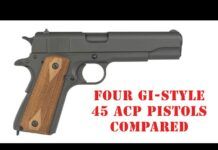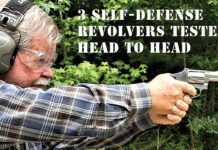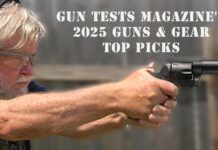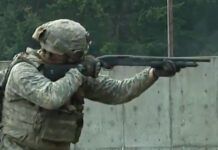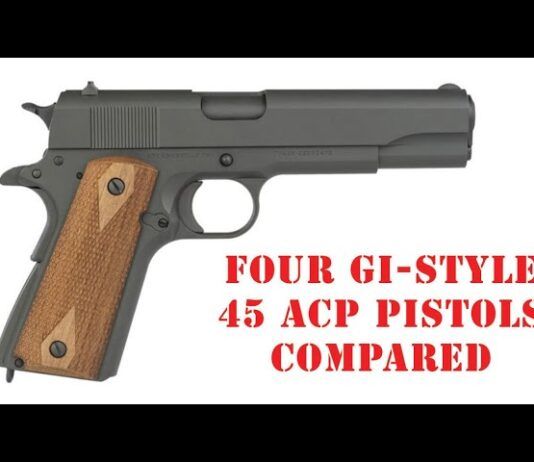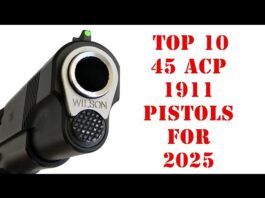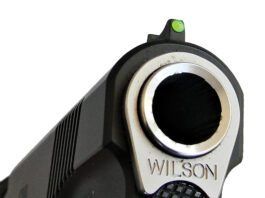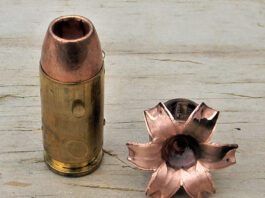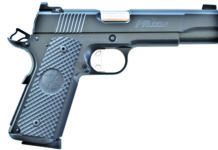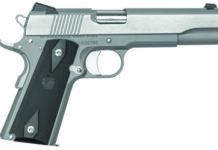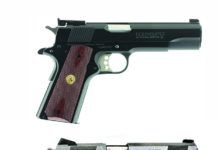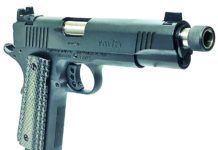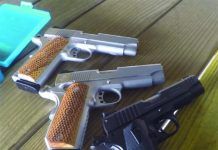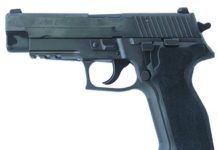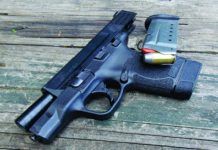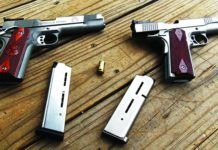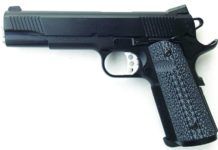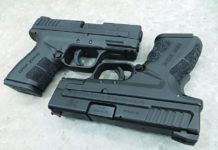Nighthawk Custom Falcon 45 ACP
Dan Wesson 1911 Heritage RZ-45 01981 45 ACP
Inexpensive Commanders: DE, Iver Johnson, Taurus, Kimber
Compact 1911s: Two Pretty Good 45 ACPs for the Money
There should be a saying: Once you shoot a 1911, you won't go back. That's how some of our testers feel about the 1911 platform, which in a properly executed handgun will have a nice trigger, comfortable grip angle, good sights, and plenty of power in 45 ACP. And 1911s that you might carry don't have to have a big footprint, so with that in mind, we looked at a Commander and two Officer-size 1911 pistols with a street cost of about $450. Inexpensive doesn't necessarily equate to value in a 1911, but with the two Officer models, one each from Taurus and Taylor's, and a Commander from American Tactical, Inc. (ATI), we found some value-packed compact 1911s. Not perfect by any means, but good performance for the cost. Of course there are compromises, but that is to be expected in a 1911 that costs about $450. In fact, if we could disassemble and reassemble these compact 1911s into one optimal compact 1911, we would take the trigger from the ATI, the sights from the Taylor's, and the receiver from the Taurus.
45 ACP 1911s: We Test Five From Les Baer, SIG Sauer, Colt
The 1911 is a legendary handgun, and it has been offered in many variations since its introduction 108 years ago. During the time after World War I, there were attempts to make the 1911 into a more accurate handgun, primarily for use at Camp Perry. The first National Match handguns were modified by Army gunsmiths for the task. Colt made the pistol commercially available as the National Match during the 1930s. The first guns featured high-profile fixed sights and were considerably tightened over the fit of the Government Model. Colt offered the Gold Cup pistol as a target pistol set up for light loads. Today, we like to have a 1911 with a lighter trigger action than the GI gun and with superior sights, but do we really need an expensive handgun or a target gun for overall utility? For personal defense and most forms of competition, the handguns reviewed will do a good job. They are useful for personal defense, some forms of competition, and for hunting varmints, and even medium-size game, at moderate range. The trick is, how much do you have to pay for this performance?
Threaded-Barrel 1911 Pistols: Some Choices Come Up Short
Last year, we began testing suppressors on rifles and handguns because we saw that the sound-abatement equipment was becoming a lot more popular. This was a surprise because suppressors are expensive and hard to transact, so it takes a lot of patience and money to get started, and there is a fair amount of legal liability if you get it wrong. Despite these drawbacks, since we began this journey suppressor regulations have become much more relaxed across the country, with all but a handful of gun-restrictive states allowing the devices. Still, it will take a couple of generations for suppressors to become mainstream and for the misconceptions about them to evaporate. For some, these unobtrusive pieces of hollow metal will always be tied to clandestine assassin or spec-ops use rather than as portable hearing protection. Pity, because during our testing with them, we have found a lot of salutary benefits behind the gun, whether long gun or sidearm. Suppressed firearms not only have shown better accuracy in most cases, they are certainly better mannered with a can hanging off the front. Muzzle flip and blast are easier to control with a can in place, and that improves accuracy and enjoyment.
We initially chose handguns chambered in 45 ACP because they offered a lot of full-power bullet weights and shapes that run below the speed of sound, so it's easy to find good ammo that suppresses well. For the handguns, we started with three full-size non-1911 45s from Glock, HK, and FN, all of which come from the factory suppressor-ready. Reviewed in the September 2018 issue, we recommended the FN America FNX-45 Tactical FDE 66968 45 ACP, $1200. We had function trouble with a Glock G21SF PF2150203TB 45 ACP, $511, and didn't recommend it. The third polymer gun was the Heckler & Koch Mark 23 45 ACP M723001-A5, $2300. It was big and expensive and very nice to shoot. Some of our testers said that if they were to buy the HK Mark 23, they would remember the day as fondly as when they got their favorite dog, which is high praise indeed.
Our 1911-style test guns this time included the Kimber America 1911 Warrior SOC 3000253 TFS with Crimson Trace Rail Master Laser Sight, $1309. We had loan of this immaculate early-model SOC with about 250 rounds through it, half of which were fired with an Osprey 45 suppressor like the one in this test. The Warrior SOC has an accessory rail built into the dust cover, which allows fitting a desert-tan Crimson Trace Rail Master laser as part of the package.
The second gun was a Remington 1911 R1 Enhanced Threaded Barrel 96339, $675, a recent in-stock price from TombstoneTactical.com. This was a well-outfitted gun for the money, coming with the 5.5-inch barrel threaded .578-28 like the others, two 8-round magazines with bumper pads, and a lot of other features we detail below.
We Compare Three New 45 ACP 1911 Commanders Under $750
The 1911 Commander is basically a full-size pistol receiver with a shorter 4.25-inch barrel and slide. These 1911 variants are more compact than the full-size issues, yet they offer all the features of the standard 5-inch-barrel variant, albeit with a bit less velocity. Some members of our team like the Commander format with the full-size grip and shortened slide, which makes the pistol easy to hang onto when firing 45 ACP as well as more comfortable to carry concealed due to the shorter barrel. One issue when carrying concealed, though, is the grip, which can print under clothing.
To see which pistol best fit our testers' everyday-carry needs, we procured three 1911 Commander models for testing: the recently introduced Taurus 1911 Commander ($459), a Metro Arms MAC 1911 Bobcut ($746), and an American Classic Commander ($568). The Taurus is manufactured in Brazil, and the Metro Arms and American Classic pistols are manufactured in the Philippines and are both brought into this country by Eagle Imports.
All three showed great fit and finish and chewed through 45 ACP ammo as fast as we could load magazines. All featured the classic GI-style domed slide, long skeletonized triggers and hammers, straight rear grip straps, dovetailed combat-style sights, flared ejection ports, extended beavertails, extended thumb safeties, textured grips, and 8+1 round capacities. In short, these pistols have all the features a modern 1911 shooter expects in a concealable package.
The Bobcut and AC came in hard-plastic cases and included one magazine. The Taurus included a plastic bushing wrench for ease of takedown. At first glance, these three Commanders looked the same in terms of features, if not cosmetics, and it was the value-added items in each that eventually allowed us to judge one over the other.
2016 Guns & Gear Top Picks
Toward the end of each year, I survey the work R.K. Campbell, Roger Eckstine, Austin Miller, Robert Sadowski, David Tannahill, Tracey Taylor, John Taylor, Rafael Urista, and Ralph Winingham have done in Gun Tests, with an eye toward selecting guns, accessories, and ammunition the magazine's testers have endorsed. From these evaluations I pick the best from a full year's worth of tests and distill recommendations for readers, who often use them as shopping guides. These choices are a mixture of our original tests and other information I've compiled during the year. After we roll high-rated test products into long-term testing, I keep tabs on how those guns do, and if the firearms and accessories continue performing well, then I have confidence including them in this wrap-up.
Compact 45 ACP Shoot-Out: Glock, S&W, and Springfield
The compact self-loading pistol is easily the most popular personal-defense handgun in America. Shooters realize that small-bore handguns may not have sufficient potential for personal defense. The 9mm Luger is the baseline for personal defense in most shooters' eyes. The 40 S&W isn't as popular due to the stout recoil it produces in compact handguns. After all, many 9mms and 40s are built on the same frame. The 45-caliber compact is slightly larger, and the lower-pressure 45 ACP gives a hard push in recoil rather than the sharp jolt experienced with the 40.
To see how our shooters rated a trio of smallish 45s, we acquired three handguns based on the service-size Glock 21, Springfield XD, and S&W M&P handguns.
l From Glock comes the single-stack polymer-frame G36, which is popular, reliable, and well suited to personal defense. The Glock G36 PI3650201FGR 45 6R FS, $561, isn't the most popular Glock by a long shot, but a number of Glock fans, as well as 45 ACP fans, like the Glock 36 handgun for its simplicity and ease of use.
l Another gun in the test was Springfield Armory's XD-S, a downsized XD with a slim single-stack grip. The Springfield Armory XD-S 3.3 XDS93345BE 45 ACP, $419, is even more compact than the Glock, with a short grip frame and a five-round magazine.
l The latest arrival in the polymer-frame 45 single-stack scene is the Smith & Wesson M&P45 Shield 180022, $399. The Shield series have been popular and well accepted by concealed carry handgunners, so making a 45-caliber version of it is a natural choice.
We test-fired the pistols with a total of five loads. The first was a handload with Magnus Cast bullets (#803 225-grain Flatpoint) and 4.8 grains of Titegroup powder. Our other test loads came from CheaperThanDirt.com. One was the HPR 230-grain JHP 45230JHP ($38/50 rounds), a Hornady 200-grain XTP ($15.28/20), a Hornady 230-grain XTP +P 9096 ($16.25/20), and a Fiocchi 230-grain Extrema JHP 45XTP25 ($17.24/25). We fired the handload during the combat firing test stage, shooting 50 cartridges in each pistol. We also fired a magazine of the Hornady 230-grain +P in these stages to evaluate recoil in each handgun. The HPR 230-grain load, the Hornady 200-grain load, and the Fiocchi 230-grain Extrema were used in accuracy testing. During the course of our testing, the three pistols never failed to feed, chamber, fire or eject, so reliability isn't an issue.
As may be expected, these compact 45s are popular with fans of each company's full-size 45s. But that isn't the whole story. As we discovered, fans of the full-size Glock may prefer the XD-S and our Springfield XD fan preferred the Glock 36 compact, and so it went. The primary difference was in handling, we found. Here are our findings.
Practical Target Guns: Kimber And Springfield Go Head to Head
In this installment, we pit two practical target guns against each other. By practical target guns we mean accurate and useful 1911 handguns suitable for personal defense, hunting, and some forms of competition. They are not so specialized that they are not holster guns or unreliable for general use. Some target guns simply are not as robust as these handguns.
Fragile sights that overhang the slide too far, as an example, are counterintuitive in an all-round packing gun. If an adjustable sight loses its zero in competition, you will lose the match. Losing zero in a personal-defense situation carries a stiffer penalty for failure. Getting down to the nitty-gritty, fiber-optic front sights are not always desirable in a hard-use handgun because they tend to be fragile, even if they deliver superior targeting performance.
On the other hand, a service pistol or a hunting pistol with adjustable sights is desirable given the wide range of bullet weights and velocity available with the 45 ACP cartridge.Gun Testsreaders already know that the 1911 Government Model platform is a versatile, go-anywhere do-anything handgun; but the question is, can target performance translate to defensive reliability and handling?
When the National Matches got into full force after World War One, improvements were undertaken on the 1911 handgun. Barrels were welded up and carefully fitted, and high-profile sights were fabricated. These improvements led to the Colt National Match pistol's introduction in 1933. The National Match featured a hand-honed action and two-way adjustable sights. Law officers and outdoorsmen also adopted this relatively expensive handgun. Changes and modification led to the Colt Gold Cup. The sights were fragile in many renditions — not the case in the newest models — so the shooter wishing to own a service-grade handgun with target sights had to take the custom route. Expedients, such as fitting Smith & Wesson revolver sights to the 1911 slide, were not always successful, but the Bo-Mar sight was an excellent addition to any 1911.
High-visibility adjustable sights are a good thing to have, provided they are reliable in keeping zero, are not fragile, and aren't likely to be damaged. Today, we have the best adjustable-sight 1911 pistols yet from the factory, and our two tests guns put them to excellent use. Here's how they performed.
Four 45s Compete for Top Carry Honors
The high-end 1911 handgun continues to be popular, so popular, in fact, that folks are willing to drop well over one thousand dollars to gain what they hope is superior performance. On a high-end pistol, "performance" often means features, such as good sights, forward cocking serrations, a good trigger compression, and attention to detail. The discerning shooter is looking for reliability first, then handling, accuracy, and fit and feel, and four handguns that are reputed to have those qualities at various price tags come from Colt and Springfield Armory.
We recently tested two sidearms chambered in 45 ACP from each company that would interest nearly any buyer who was in the market for a self-defense arm. The products were Springfield's Loaded Model PX9109LP, $790; and for hundreds more, the company's Tactical Response Pistol, the TRP PC9108LP 45 ACP, $1347. To fit in that sizable price gap in the Springfield lineup, we selected Colt's Combat Elite 08011XSE, $1015, and the Rail Gun XSE 01070RG, $1199. These are actual counter prices from BudsGunShop.com, and our intent was to survey a range of pricing to see if additional dollars translated into additional performance that would matter to our test team of shooters.
Among the most popular sidearms in terms of numbers sold are the Colt Combat Elite and the Springfield Loaded Model. A Colt Rail Gun variant is used by the U.S. Marine Corps, and the Springfield Bureau Model, similar to the TRP, by the FBI SWAT team. All four are combat guns intended to give the user an advantage in the field, so our thorough test involved a number of trained shooters who were asked to push the pistols to the limit, so we could discover the boundaries of control, combat accuracy, and absolute accuracy. We should also note that the Loaded Model was a rater's personal carry gun. The rater stated it came out of the box running and has never given a complaint, and it has some 5,000 rounds through it. Cosmetically, it was hard to assess the status of the Loaded by just looking. The pistol is finished in a dull, non-reflective Parkerized finish that doesn't show wear very much. The other pistols were new out of the box.
At this point we will mention the holsters used, as the Rail Gun demanded rail-specific holsters. The other three guns were easily passed around to the raters and standard holsters were used for them. For the Rail Gun, we had to invest in two holsters specific to it, with three raters doing most of the firing. We used Ted Blocker's X 16 holster in both standard and 1911 rail-gun types. The holster was used both strong side and crossdraw, with excellent results. We also used a ZZZ Custom Kydex strong-side holster, which gave a good fit on the Colt's long bearing services and is relatively compact for a rail-gun holster. The other holster was a Sweetwater Saddlery strong-side pancake design that hugs the body.
At the range, we used three loads. The Black Hills Ammunition 200-grain lead semi-wadcutter bullet was our training and practice load. Next, the Hornady American Gunner 185-grain XTP represented a lightweight-bullet defense load, and the Winchester M1911 230-grain jacketed hollowpoint stood in as a heavy defense load. These are affordable 45 ACP choices likely to be used by shooters. We expected that heavy bullets with a long bearing surface would demonstrate good accuracy, but in this case, the lightest bullet weight gave the best accuracy. Also, our shooters noted the heavier push of the 230-grain load. Following are objective data about each handgun, as well as the subjective opinions of our shooters based on head-to-head firing tests.
9mm and 45 ACP XD Mod.2 Subcompacts Go Head to Head
The compromise that shooters have to deal with in choosing a concealed-carry sidearm is this: A smaller pistol that is easier to conceal is usually more difficult to operate and shoot; and a larger pistol that is easier to operate and shoot is more difficult to conceal. A line of guns retailers have told us are popular carry pieces are the newest Springfield Armory XD variants, the XD Mod.2 series.
They are supposedly redesigned XD subcompacts that have better ergonomics, more useful sights, and slimmer profiles. If you are looking for a concealed-carry handgun that offers a super-slim profile, less weight, and better concealability, we suggest you stick with a single-stack pistol like Springfield's XD-S 3.3, which we reviewed in February 2015 (Grade A). On the other hand, if you want a pistol that is still concealed-carry friendly but has nearly double the magazine capacity with the feel of a full-size pistol, the Mod.2 pistols are supposed to fill that ticket. So we tested the two most-popular chamberings of the Mod.2 pistols in 9mm Luger and 45 ACP to see what all the fuss is about. The question that needed to be answered is, are these new guns so good that we would recommend you considering switching from your favorite carry piece? That is a super-high barrier for any handgun to scale, and, ultimately, each concealed-carrier has to make the decision to try them on his or her own.
The trend these days with law enforcement is to move to the 9mm cartridge, and many agencies we are acquainted with are using 147-grain ammo. So we selected 147-grain cartridges from Atlanta Arms as well as 115-grain rounds from Black Hills and Hornady. For the 45 ACP, we stuck with the most popular bullet-weight choice, 230 grains, selecting FMJs from Perfecta and Federal and hollowpoints from Atlanta Arms. We had no experience with Perfecta 45 ACP ammo, but found it at a big-box store and thought we'd try it.
We fired for accuracy at 25 yards using the provided flush-fit magazines and a rest. We also fired for speed at 15 yards with both magazines, and with the flush-fit magazines drew from concealed carry using the included belt holsters and a Fobus IWB holster that uses either a large or small universal shell. The flexible backing of the Fobus ensures the pistol stays secure when worn. We practiced dry-firing drills with both pistols using both holsters and progressed to live fire. By no means could these pistols be dropped in a pants pocket; they need a holster.


